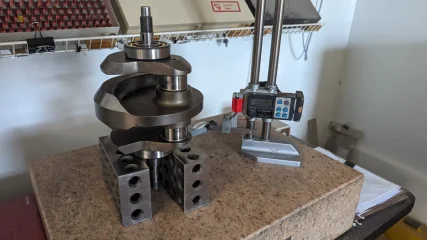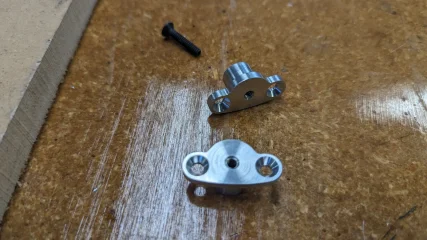johnfitzw
VIP MEMBER
- Joined
- Jun 19, 2014
- Messages
- 43
Hey all...
Quick update to answer questions and give thanks to all for their input and suggestions.
Concours was correct in hís diagnosis and eagle eyed observation that the crankshaft boss has been contacting the outer race, and that has caused the failure of the outer mains race.
However, I don't believe it was caused by faulty manufacture of either crank or cases - it was by an assembly setup error by me when adapting my one piece RoDy Atlas style crank into the SBR billet cases (the alternator rotor key location is the only diff between Atlas & Commando racing cranks and Greg at RoDy had a ready to go Atlas style crank on the shelf when I needed one)
I reassembled the crank and cases with the still cracked mains to check that there was end float... And indeed there was - 0.015" - so preload wasn't cause.
SBR cases are machined for a Mk 3 850 crankshaft, which, I believe, is 3mm wider between the main bearings locations than the pre Mk3 models. To run a pre Mk3 crank in Mk3 cases you obviously have to add 3mm to the take up this additional clearance.
My problem was caused by the the manner I chose of shimming up this additional clearance. I chose to add a 1.5mm shim BEHIND each main bearing outer race rather than on the crank itself behind the lipped inner race. Placing the shims behind the mains outers has the effect of moving them out of their bores in the crankcase - you can see this protrusion clearly in the photos of the crankcase and fitted bearings.
My additional error was not considering / realising / checking that the crank wasn't contacting the protruding outer races. I simply assumed that the end float I was measuring was between the inner race and the outer race. Assumption is The Mother..
As the crank had plenty of end float, the cracking was caused by the crank being driven to left or right against the mains outers under load or deceleration.
I have new mains to hand now, and am considering splitting the shimming to both locations - some on the crank, some behind the mains outers. And I will check for clearance tween crank and mains outers..
I'll report back..
Thanks again all....
Quick update to answer questions and give thanks to all for their input and suggestions.
Concours was correct in hís diagnosis and eagle eyed observation that the crankshaft boss has been contacting the outer race, and that has caused the failure of the outer mains race.
However, I don't believe it was caused by faulty manufacture of either crank or cases - it was by an assembly setup error by me when adapting my one piece RoDy Atlas style crank into the SBR billet cases (the alternator rotor key location is the only diff between Atlas & Commando racing cranks and Greg at RoDy had a ready to go Atlas style crank on the shelf when I needed one)
I reassembled the crank and cases with the still cracked mains to check that there was end float... And indeed there was - 0.015" - so preload wasn't cause.
SBR cases are machined for a Mk 3 850 crankshaft, which, I believe, is 3mm wider between the main bearings locations than the pre Mk3 models. To run a pre Mk3 crank in Mk3 cases you obviously have to add 3mm to the take up this additional clearance.
My problem was caused by the the manner I chose of shimming up this additional clearance. I chose to add a 1.5mm shim BEHIND each main bearing outer race rather than on the crank itself behind the lipped inner race. Placing the shims behind the mains outers has the effect of moving them out of their bores in the crankcase - you can see this protrusion clearly in the photos of the crankcase and fitted bearings.
My additional error was not considering / realising / checking that the crank wasn't contacting the protruding outer races. I simply assumed that the end float I was measuring was between the inner race and the outer race. Assumption is The Mother..
As the crank had plenty of end float, the cracking was caused by the crank being driven to left or right against the mains outers under load or deceleration.
I have new mains to hand now, and am considering splitting the shimming to both locations - some on the crank, some behind the mains outers. And I will check for clearance tween crank and mains outers..
I'll report back..
Thanks again all....
Last edited:













